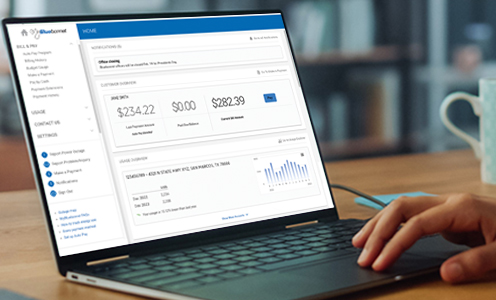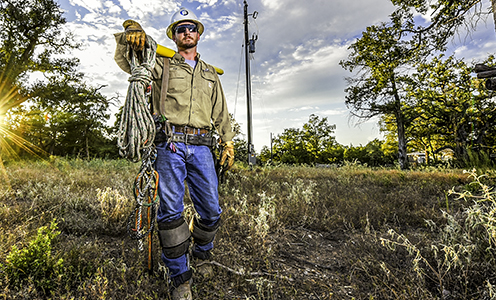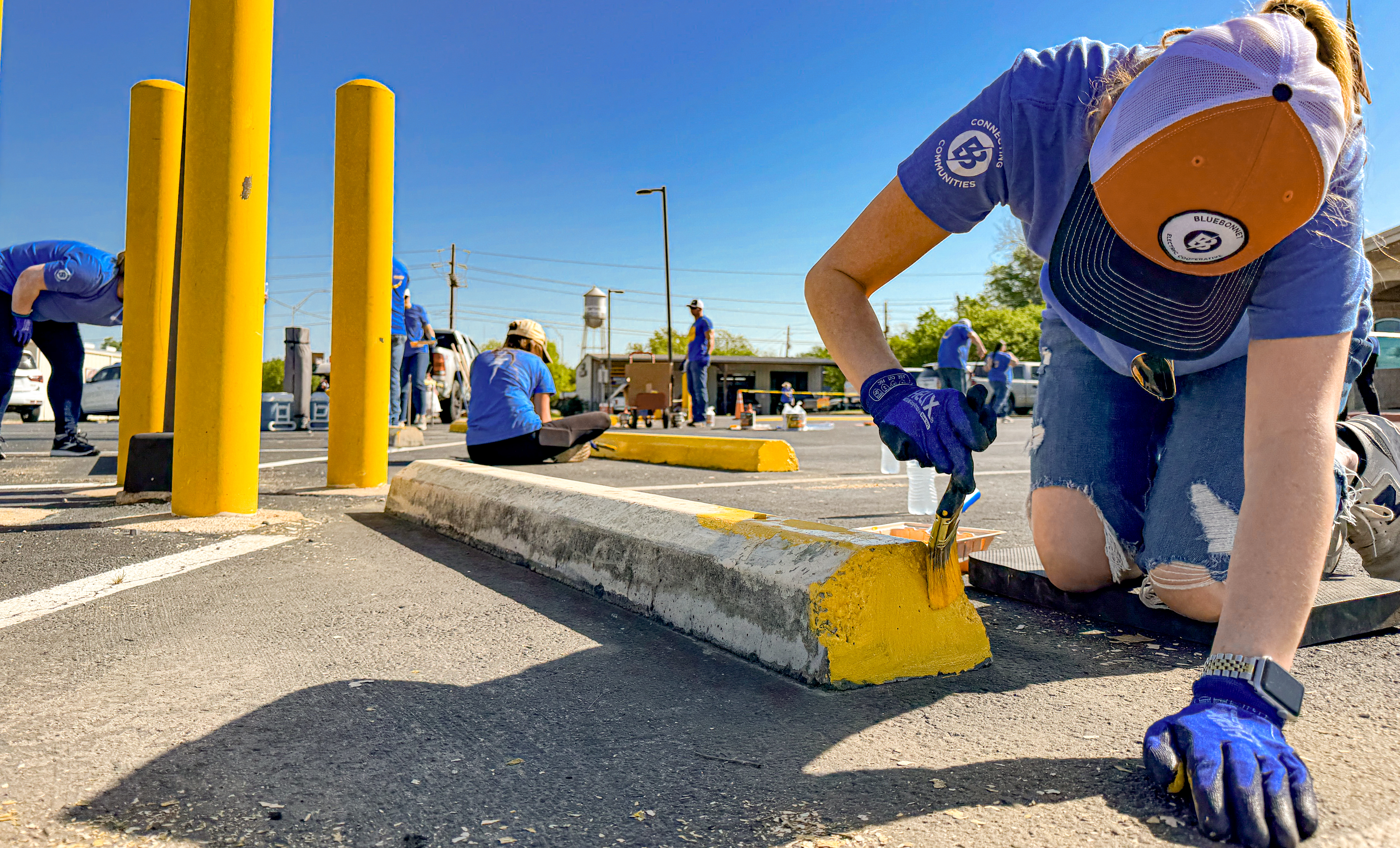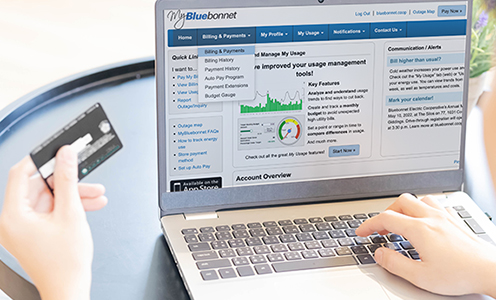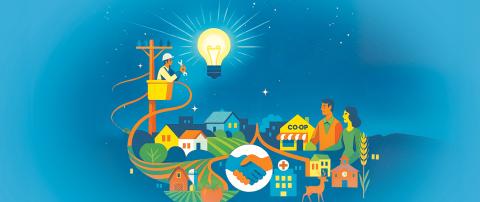The cooperative way
Recent news
Story by Kristin Finan
When Mark and Sunny Woelfel settled onto 3 acres of family land in Giddings in 2014, it was clear they were right where they were meant to be. “It was always a lifelong dream to move to Grandpa’s place,” said Mark Woelfel, a Bluebonnet member.
But as they researched ideas for building a home on the Lee County property, they were drawn to a particular concept: the “barndominium.” The word, popularized in the 1980s, is the name given to the transformation of a barn-like space into a home. In recent years, barndominiums are often built from a variety of metal-frame buildings.
After removing an existing mobile home from the property, the Woelfels spent a year living on-site in an RV with three of their five children — the other two are adults who visit frequently — while the home was built. Last summer, they moved into their new Pinterest-worthy, two-story 3,200-square-foot barndominium, which centers around a sprawling great room and is adorned with lovingly restored furniture that has been in the family for generations.
It was custom built by Exner & Snyder Custom Homes. The company, based in Giddings, works on both barndominiums and traditional houses across the Bluebonnet Electric Cooperative service area. Both styles of homes average about $135 per square foot, said owner and founder Jonathan Snyder of the company. The Woelfel house, however, cost roughly $100 per square foot to build.
The concept of barndominiums (“barn” plus “condominium”) is not new. Rural homeowners have transformed wood or metal barn structures into living spaces for generations. In recent years, however, thanks to websites like Pinterest and home design shows such as Chip and Joanna Gaines’ HGTV series “Fixer Upper,” (which first featured a barndominium in 2016), the trend has gotten bigger and grander.
Stacee Lynn Bell, aka “The Barndominium Lady,” has designed nearly 150 barndominiums across the country, including some being constructed in the Bluebonnet area.Bell, who is based in the small East Texas town of Cleveland 45 miles northeast of Houston, said that in the South, especially in Texas, “barndos” are typically steel-frame structures that often include a workshop or garage. They can be built within an existing metal structure or completely from scratch. They generally feature a metal, rectangular frame that has been finished out on the inside, meaning the inside has the feel of a traditional house but is centered around an open-concept great room. In other parts of the country, she said, wooden “pole barns” or engineered wood frame structures are more common. The exteriors of barndominiums can vary greatly, ranging from a traditional, barn-like feel to a more modern metal façade.
Although the barndominium trend is nationwide, it is especially popular in Texas, Oklahoma and Georgia, the website barndominiumlife.com states. Although the cost of building a new metal-frame home tends to be comparable to that of a basic wood-frame home, people are drawn to the aesthetics of barndominiums and the fact that their design – which typically features energy-efficient windows, lots of natural light and spray-foam insulated walls and attics – can be as energy efficient as their wood counterparts. They are also more durable and resistant to heat, weather and pests than wood-frame structures, said Elliott Lukasik, owner of Pristine Designs, which creates floor plans for about a dozen home builders in Central Texas.
Lukasik, who has been drawing floor plans for 28 years, has been asked to design metal-frame homes since the early 2000s. He didn’t regularly start hearing the word barndominium until seven or eight years ago. These days, he said, nearly half of the 100 plans he draws each year are for barndominiums, and most are in the Bluebonnet area.
“Originally it was something really simple, something cheap to get into, something to live in. Now, some of the barndominiums are Taj Mahals, big and elaborate and really nice,” he said. “If you think you’re living in a barn, it’s really not a barn. These can be more expensive than doing a conventional wood-frame build. It’s really what you want to put into it.”
Most Texans opt for metal frames rather than wood frames, in part because they like the look, Lukasik said. For do-it-yourself projects, metal-frame home kits are easier to assemble than wood-frame kits.
The average barndominium buyer is looking for a home in the 1,500 to 2,200-square-foot range, although some go as big as 4,000 square feet. The most requested plan is a one-story rectangular home, Lukasik said, but upstairs lofts are also popular.
Snyder of Exner & Snyder Custom Homes has seen demand for barndominiums increase in the past 15 years.
The company works on six or seven barndominiums a year, concentrating on the area between Brenham and Bastrop. “The lending was really hard to get on them before, because the banks didn’t know what to do with them as far as taxing and values on the building, but they’ve become a lot more mainstream on the market,” Snyder said.
They are popular in part because metal exteriors allow for less upkeep (you don’t have to paint them, for example) but the interiors allow for greater creativity.
“You start out with a big main structure and then really you can build anything you want on the inside,” he said. “They can be simple buildings, but they can be super extravagant on the inside. It’s really about your imagination.”
Most of the houses take 6 to 8 months to build, Snyder added. “We are a complete custom builder, so we are customer-first driven,” Snyder said. “We sit down with the customer to help them envision what they want and make sure they get the product they envisioned.”
Bluebonnet member Kathy Anderson and her husband, Jay Anderson, are building a barndominium outside Giddings with the help of Exner & Snyder. They expect their 2,200-square-foot home to cost around $300,000. The couple will live next door to Kathy Anderson’s sister.
“It took me a long time to find a floor plan for what we wanted,” said Anderson, who hopes to eventually add a large garden, chickens and a small orchard on the property. “You want to maximize your best views. Don’t be afraid to draw it out on paper and ask a lot of questions. I had my notepad with me all the time. Think of questions and shoot them over right away.”
Bluebonnet member Christa Wilson, who lives in Cypress near Houston, dreamed of building a place where she and her twin sister, Corrin Wilcox, could retreat with their families on weekends. After falling in love with Brenham, the sisters purchased 7 acres there to build a traditional house they could share. Then they watched the “Fixer Upper” barndominium episode in 2016 and changed directions.
“We wanted the big grand room that had everything,” said Wilson, who has five children. Her sister has three children. “We wanted a space for our family to hang out. It’s like a party barn pretty much.”
Wilson and Wilcox, both former teachers turned stay-at-home moms, decided to be their own general contractors, purchasing one large red metal building frame from Mueller, Inc., a West Texas-based steel manufacturer with 33 locations across the Southwest. Construction of the building — which includes 4,000 square feet downstairs, half of which is the great room, and 1,000 square feet upstairs — took about four months.
The barndo, which also includes a 1,500-square-foot covered patio, was ready in January 2017. Since the house can sleep 28 people, Wilson and Wilcox decided to rent it out when they weren’t using it. You can get a taste of their barndo life by booking a stay on their website, 12armadillos.com, or by searching “barndominiums” in Central Texas on home rental websites Airbnb or VRBO.
Amanda Hart embraced the barndominium life well before it became a trend. She and her husband, Jon, a Bluebonnet member and welder, started hand-building their first barndominium on their 10-acre property in Winchester in 2005. The initial structure was 26 feet by 50 feet, half of which the couple enclosed to be their home, which they moved into in 2007. The couple used the other half of the building as a welding shop.
“It was literally going to be a barn and a shop, but then we decided, ‘Why have this big space and wait to build a house later when we could just make this our house?’ ” she said.
After their family expanded to include three kids, they enclosed the rest of the 26-by-50-foot structure for living space and started an 18-by-36-foot add-on completed in 2019. They also added a back porch, carport and another bathroom.
“We had a kitchen and a living room, but we didn’t have anywhere to sit down and eat as a family,” she said. “We wanted to be together and we needed the additional space to be able to do that. I love it. To be able to do it yourself really gives you another level of appreciation for what you have.”
Hart estimates that hiring a contractor for the work would have cost twice as much.
Bluebonnet member Dawn Hedgpeth and her husband, Jesse, also plan to embrace the do-it-yourself barndominium approach, downsizing from a 3,500-square-foot house in Dickinson, 30 miles southeast of Houston, to live temporarily in a 320-square-foot shed-house on 8 acres in Bastrop. They purchased the property because it has an empty 2,000-square-foot metal building they plan to convert to a barndominium over several years.
“We’re hoping to do most of the work ourselves,” she said, but they are working with Tello Welding and Construction of Giddings on the project.
The estimated cost for their property and construction is about $300,000. The Hedgpeths have been interested in barndominiums for more than 20 years and are excited to work on the project. After living through hurricanes on the Gulf coast, Dawn Hedgpeth can tile and build cabinets.
“We’re in our mid-50s. We could just as easily buy a little condo somewhere and have money set aside and travel, but this is an adventure, and we like doing this sort of stuff together,” she said. “We get to do something together and say, ‘Look what we did. This is ours. We built it.’
Area builders in and near the Bluebonnet service area
- Texas Barnodminiums
- Exner & Snyder Custom Homes (512-304-8928)
- Tello Welding and Contruction (979-716-0343 or Facebook)
READ UP: There are multiple books about barndo designs and layouts online, or read “Barndominium Lifestyle,” a bimonthly magazine.
ON THE WEB: There are Facebook groups dedicated to barndominiums, including “Texas Barndominiums,” “Barndominium Homes” and “Barndominium Life” (by barndominiumlife.com). Texas Barndominiums has a YouTube channel where you can learn more.
Home Kits, a do-it-yourself option
Folks who want to build a barndominium but are on a budget may opt for a home kit.
What does a home kit include? Typically a floor plan and prefabricated components to build a one-, two- or three-bedroom home including a bathroom, great room, kitchen, dining room and laundry room.
How much does it cost to build a barndominium using a kit? Barndo home kits can be significantly cheaper than building a traditional home or hiring a contractor if you do it yourself.
Pros: If you plan to hire help, expect to pay a general contractor less if you use a home kit. Kits cut construction time as well as labor and building costs.
Cons: Home kits and what they include vary from company to company, so do a lot of research. Even if you plan a DIY, you’ll likely need to hire subcontractors for items such as a septic system, plumbing, electrical, fireplace and HVAC. On average, expect to pay $60 to $135 per square foot with a home kit.
Where to buy: A few Texas-based companies that offer home kits are General Steel Corp., Absolute Steel Texas, Capital Steel Industries, Mueller Inc. and Texas Barndominiums.
Sources: barndominiumlife.com and gensteel.com
Download this story as it appeared in the Texas Co-op Power magazine »
Bluebonnet Electric Cooperative offers several ways for members to seek help paying their bill. These self-service options are available 24/7 online, on the MyBluebonnet mobile app and through our automated phone system.
ONLINE
Our website offers information about payment extensions, local energy assistance providers and other helpful information such as a weatherization program that covers home improvements to reduce your power bill.
When you request a payment extension, you will be directed to log in to your MyBluebonnet account. If you haven’t yet registered for a MyBluebonnet account, on the login screen click “Sign up to access our Self Service site.” You can also click Register at the top of bluebonnet.coop. Once you’ve logged in, click on the Billing & Payments tab, then the Payment Extensions link.
This option gives qualified members an extension on the due date of their current monthly bill. The member must be past due only on their current bill, have applied within 10 days of the due date and have met the requirements of previous payment extensions.
If you are looking at bluebonnet.coop on a mobile device, you will need to log in to your MyBluebonnet account. Click on Billing & Payments, then Payment Extensions.
MOBILE APP
On the MyBluebonnet mobile app, log in and click on the Bill & Pay icon, then Payment Extensions. Click the small ‘I’ in the top right corner of the screen for more information about payment extensions. If you haven’t downloaded the new app, just search MyBluebonnet in Apple’s App Store or Google Play. Members can register for a MyBluebonnet account through the app’s launch screen. Click “Don’t have an account? Register now.”
BY PHONE
The MyBluebonnet automated phone system now offers members the option to request a payment extension. Call 800-842-7708, and once prompted, press 2 to use the automated system, then press 2 to request a payment extension.
Bluebonnet knows that the COVID-19 outbreak continues to financially impact many families and businesses. We do our best to work with members who need help with their electric bill. If these self-service options don’t meet your needs, call a member service representative at 800-842-7708 between 8 a.m. and 5 p.m. Monday through Friday.
